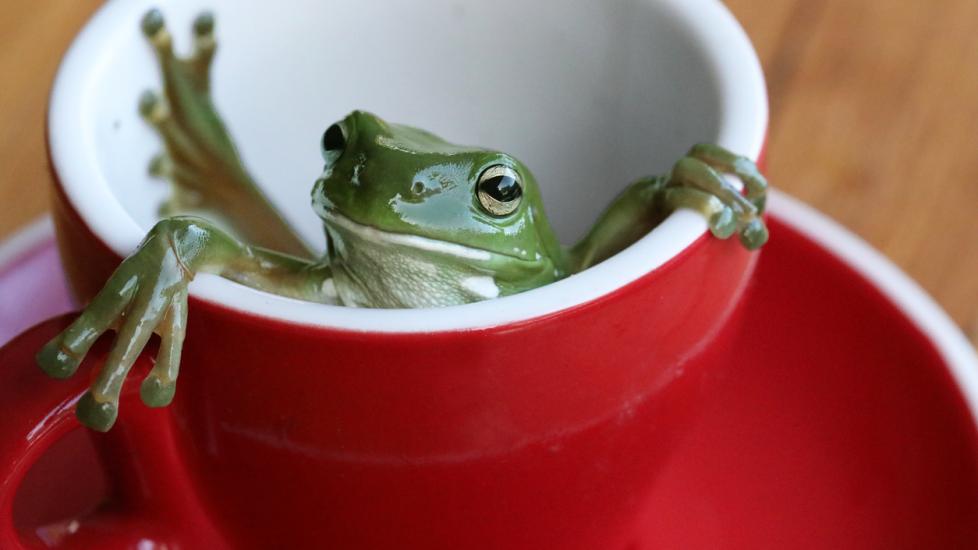What Do Frogs Eat?
Feeding pet frogs can be one of the most fascinating and engaging activities for pet parents. Most frogs feed on living invertebrate prey items in the wild making them insectivores. Many invertebrate prey items are regularly available in the pet trade making it easy to provide an adequate diet for pet frogs.
Although live prey items are available for frogs, captive frogs can be conditioned to eat a pelleted diet, which is often easier with aquatic species. A complete captive diet allows pet frogs to live a long and healthy life as a companion.
Foods for Frogs
A varied diet with a combination of live and pelleted food items will provide not only nutritious diet, but enrichment for the animals as frogs will be able to demonstrate their natural predatory behavior.
A combination of the food items listed below can provide a complete diet to your frog:
-
Commercial Diets: Commercial diets can be nutritionally more complete for a frog. These diets can provide minerals and vitamins that are typically not found when feeding live prey items. Pelleted frog foods are available but mainly for aquatic species, some aquatic turtle foods can be used as a substitute for frogs.
-
Crickets can be commonly found in pet stores to offer your frog. Remember to always gut load crickets using a high calcium gut load formula.
-
Dubia roaches are unique in that they are easy to breed and produce at home. Commercial diets exist that make this species easy to breed at home.
-
Black Soldier flies have recently become more available for frog hobbyists. These are higher in calcium than most insect species and provide an excellent form of nutrition.
-
Earthworms and Redworms are readily available at bait and tackle shops.
-
Mealworms and Superworms are often found in pet stores, which makes them readily available. These should always be gut loaded prior to feeding to any frog to provide complete nutrition. Additionally, these insects have a high amount of chitin (a cellulose-like biopolymer) in their exoskeleton which makes them harder to digest. Feeding these exclusively and in high quantities can lead to digestive problems such as constipation.
-
Waxworms should be offered in a limited quantity or be used as treats as they typically have a higher fat content than most other food items available. Feeding frogs exclusively waxworms can lead to obesity.
-
Fruit flies can be used to feed many smaller frog species such as dart frogs. These can also be cultured at home and can be a sustainable food source for any owner.
-
Small mice (pinky or fuzzy mice) can be offered to some larger frog species as a treat, once or twice a month. Overfeeding frogs with mice can lead to obesity and other nutritional issues.
Insects that are fed to amphibians should be cared for based on each insect species specific requirements; to provide insects the ability to grow and complete their life cycle. Provide adequate diets for each insect species. There are many that are commercially available. Additionally, water should be provided using gel cubes or a cotton ball in a cap of water. Feeding wild insects to frogs should be limited to prevent the transmission of disease.
Prey items offered to frogs need to be an appropriate size relative to your frog. For example, fruit flies would not be able to sustain a White’s Tree frog, while a frozen thawed mouse of any size would be too big for even the largest dart frog species.
Supplementation
Prior to feeding any insects, nutritional value can increase by performing one or two of the following methods of nutrient or vitamin supplementation.
Gut Loading: Many captive insect species do not have the correct calcium and vitamin contents to provide a balanced diet to frogs. Specialized diets exist to increase the nutrient and vitamin contents of the insects. Insects need to be fasted prior to feeding them a diet that is high in nutrients (calcium) and vitamins. The insects should be offered the food items 6-72 hours prior to feeding your frog. This will increase the nutritional content of the insects. These insects should be offered to your frog to deliver a nutritious diet.
Dusting insects: This should be performed immediately prior to feeding any frogs. Dusting can increase the calcium and vitamin levels on the insects that are being fed to your frog. Commercially produced calcium powders and multivitamin powders are placed within plastic bag or a deep cup with the insects. Then, the bag or cup is shaken until the insects are covered in the powder. The insects are promptly fed to the frogs.
What Can Frogs Not Eat?
Frogs should not be offered any human food items for their diet. This can lead to nutritional disease. If you are looking for advice on what to and how to feed your pet frog, consult with a veterinarian who has amphibian experience. Veterinarians with amphibian experience can be found through the Association of Reptile and Amphibian Veterinarians Find a Vet function.
Featured Image: iStock.com/Lincoln Beddoe
